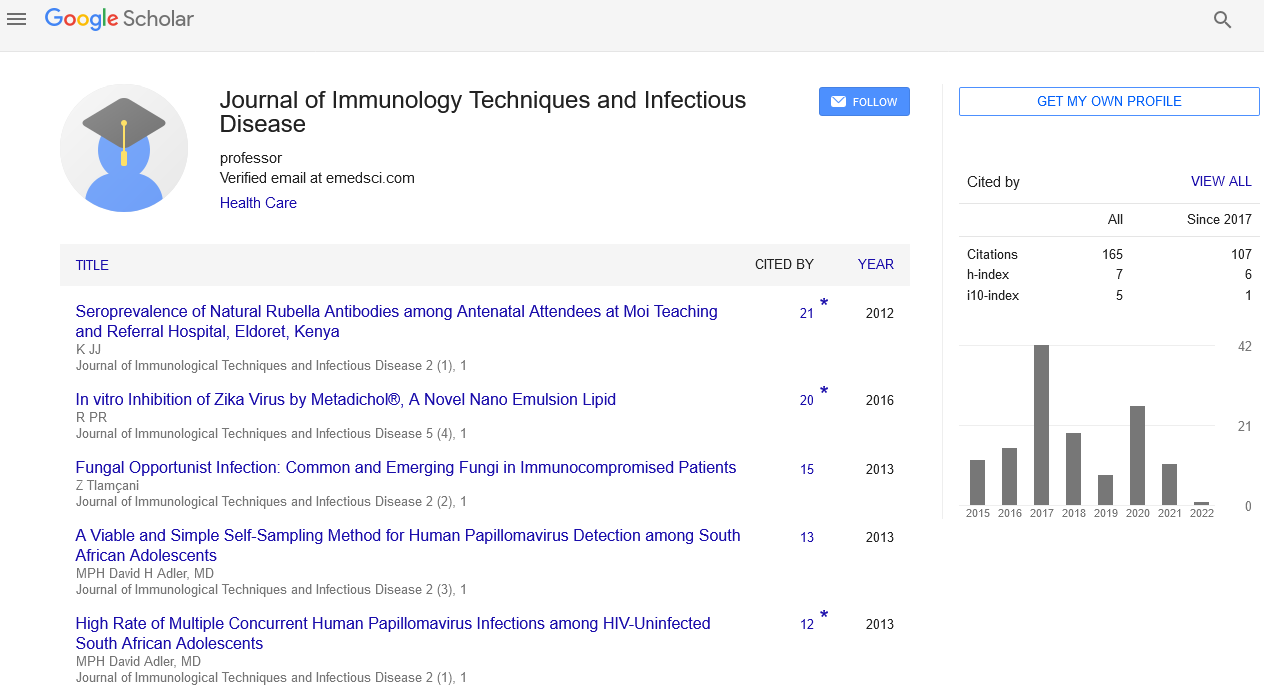Opinion Article, J Immunol Tech Infect Dis Vol: 13 Issue: 2
Immunology Essentials: The Immune System and its Complex Functions
Chen Yang*
1Department of Immunology, Third Military Medical University, Chongqing, China
*Corresponding Author: Chen Yang,
Department of Immunology, Third Military
Medical University, Chongqing, China
E-mail: yang.ch@gmail.com
Received date: 28 May, 2024, Manuscript No. JIDIT-24-146393;
Editor assigned date: 31 May, 2024, PreQC No. JIDIT-24-146393 (PQ);
Reviewed date: 14 June, 2024, QC No. JIDIT-24-146393;
Revised date: 21 June, 2024, Manuscript No. JIDIT-24-146393 (R);
Published date: 28 June, 2024, DOI: 10.4172/2329-9541.1000381.
Citation: Yang C (2024) Immunology Essentials: The Immune System and its Complex Functions. J Immunol Tech Infect Dis 13:2.
Description
Immunology is the branch of biomedical science that focuses on the study of the immune system, the body's immune mechanism against pathogens, including bacteria, viruses, fungi, and parasites. This intricate system protects the body from infection and disease while maintaining homeostasis. The field of immunology encompasses a wide range of subjects, from the basic mechanisms of immune responses to the development of vaccines and immunotherapies.
Components of the immune system
The immune system is composed of various cells, tissues, and organs that work together to detect and eliminate pathogens.
Physical barriers: The skin and mucous membranes act as physical barriers to prevent pathogen entry.
Cells: Phagocytic cells such as macrophages and neutrophils engulf and destroy pathogens. Natural Killer (NK) cells target and eliminate infected or abnormal cells.
Proteins: The complement system, a group of proteins in the blood, assists in infection removal by increasing inflammation and phagocytosis.
Adaptive immunity: The adaptive immune system provides a specific response to pathogens and includes memory, allowing for a faster and more robust response upon subsequent exposures.
Lymphocytes: B cells and T cells are the main cells of the adaptive immune system. B cells produce antibodies that neutralize pathogens, while T cells have various functions, including killing infected cells (cytotoxic T cells) and regulating immune responses (helper T cells).
Antibodies: These are proteins produced by B cells that specifically bind to antigens (foreign substances) on pathogens, marking them for destruction.
Development of the immune system
The development of the immune system begins in the child and continues throughout life. Important organs and tissues involved in this development includes. Bone marrow is the major source of new blood cells, including immunological cells. Haematopoietic stem cells in the bone marrow produce all blood cells, including lymphocytes. Thymus is an organ located in the chest where T cells mature. The thymus educates T cells to distinguish between self and non-self, ensuring that the immune system does not attack the body’s own tissues. Secondary lymphoid organs, such as the lymph nodes, spleen, and Mucosa-Associated Lymphoid Tissue (MALT), are located where immune responses are initiated. These organs provide environments for immune cells to encounter antigens and become activated.
Mechanisms of immune response
The immune response involves a sequence of procedures for identifying and eliminates pathogens. The immune system recognizes pathogens through molecules known as antigens. Innate immune cells have Pattern Recognition Receptors (PRRs) that detect common Pathogen-Associated Molecular Patterns (PAMPs). Adaptive immune cells recognize specific antigens through receptors on B and T cells. The immune system develops a response to eliminate the pathogen. Phagocytes engulf and digest pathogens, while cytotoxic T cells eliminate the infected cells. B cells produce antibodies that neutralize pathogens and facilitate their clearance. After the infection disappears, the immune system maintains a memory of the organism. Memory B and T cells persist in the body, allowing for a faster and more effective response if the pathogen is encountered again.
Immunodeficiency disorders
Immunodeficiency occurs when one or more immune system components are insufficient, causing increased susceptibility to pathogens.
Primary immunodeficiency: These are inherited diseases that impact the immune system's development and function. Examples are Severe Combined Immunodeficiency (SCID) and Common Variable Immunodeficiency (CVID).
Secondary immunodeficiency: These are acquired conditions that result from external factors, such as infections (e.g., HIV/AIDS), malnutrition, or immunosuppressive medications.
Vaccination and immunotherapy
Vaccination and immunotherapy are powerful tools that establish the immune system to prevent and treat diseases. Vaccines stimulate the immune system to produce a protective response without causing the disease. They can be made from weakened or inactivated pathogens, subunits of pathogens, or nucleic acids (mRNA vaccines). Vaccination has led to the eradication of smallpox and the significant reduction of many other infectious diseases. Immunotherapy involves manipulating the immune system to treat diseases, particularly cancers and autoimmune disorders. Monoclonal antibodies are laboratoryproduced molecules that can target specific antigens on cancer cells or modulate immune responses in autoimmune diseases. Checkpoint inhibitor drugs block proteins that inhibit immune responses, allowing T cells to attack cancer cells more effectively. CAR-T cell treatment involves modifying a patient's T cells to express a receptor that particularly targets cancer cells.
 Spanish
Spanish  Chinese
Chinese  Russian
Russian  German
German  French
French  Japanese
Japanese  Portuguese
Portuguese  Hindi
Hindi 
